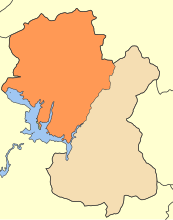Agrafa (Municipality)
|
Agrafa Άγραφα |
|
|---|---|
 |
|
| Coordinates: 39°8′N 21°39′E / 39.133°N 21.650°ECoordinates: 39°8′N 21°39′E / 39.133°N 21.650°E | |
| Country | Greece |
| Administrative region | Central Greece |
| Regional unit | Evrytania |
| Area | |
| • Municipality | 920.3 km2 (355.3 sq mi) |
| • Municipal unit | 28,826 km2 (11,130 sq mi) |
| Elevation | 800 m (2,600 ft) |
| Population (2011) | |
| • Municipality | 6,976 |
| • Municipality density | 7.6/km2 (20/sq mi) |
| • Municipal unit | 1,142 |
| • Municipal unit density | 0.040/km2 (0.10/sq mi) |
| Community | |
| • Population | 398 (2011) |
| Time zone | EET (UTC+2) |
| • Summer (DST) | EEST (UTC+3) |
| Postal code | 360 73 |
| Area code(s) | 22370 |
| Vehicle registration | ΚΗ |
Agrafa (Greek: Άγραφα) is a village and a municipality in Evrytania, Central Greece. Its administrative center is the village Kerasochori. It is named after the wide mountainous region of Agrafa, of which it occupies only the SW part.
It consists merely of villages and hamlets spread on the mountain slopes around the river Agrafiotis. Likewise the rest of Agrafa area, they are famous for their complete autonomy throughout the four centuries of Ottoman occupation of Greece, being home to many bands of fighters against the Ottoman rule; most notably of Antonis Katsantonis who is considered as the local hero.
Despite their natural beauty, the villages are still virgin from touristic exploitation. There are some basic facilities in the bigger villages - family-run hostels and taverns.
The municipality Agrafa was formed at the 2011 local government reform by the merger of the following 5 former municipalities, that became municipal units (constituent communities in brackets):
The municipality has an area of 920.341 km2, the municipal unit 288.574 km2.
...
Wikipedia


